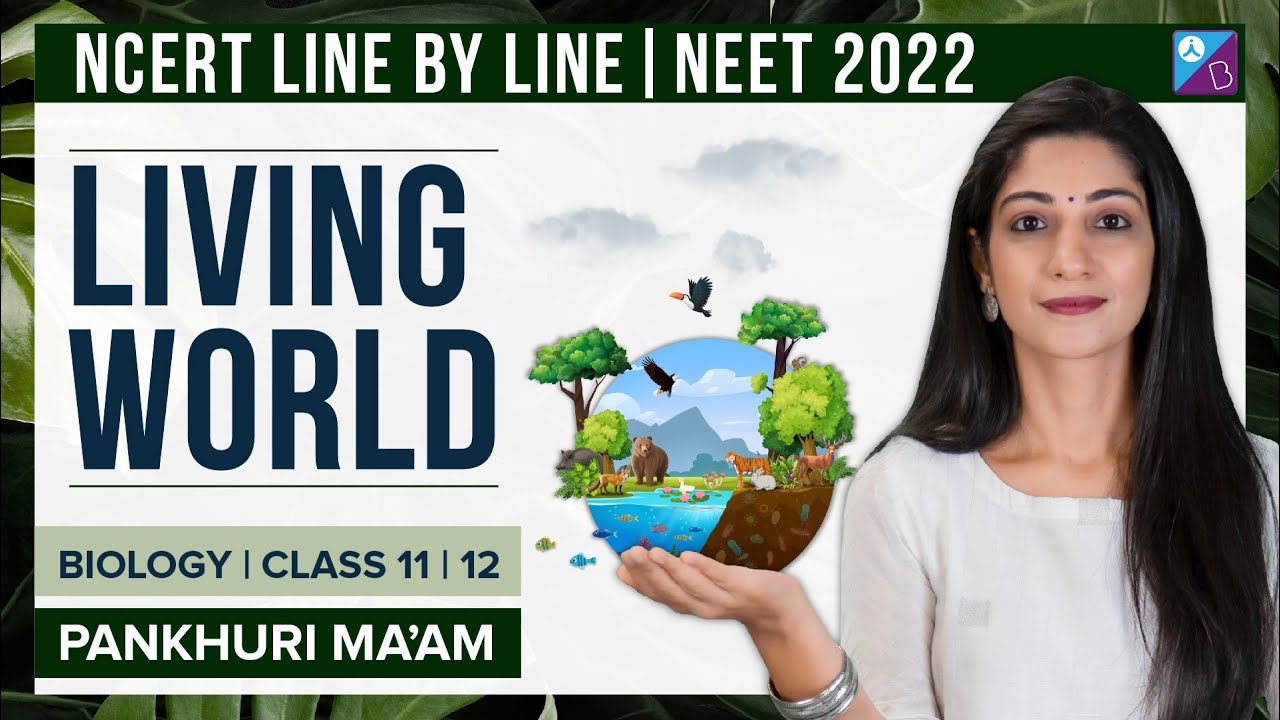Get access to the complete set of notes for The Living World covered under NEET Biology syllabus. Important notes for NEET Biology The Living World is notably advantageous to all the candidates preparing for the exam, as you can refer to these for the most important points of the topic. Conceptual clarity is important for an exam like NEET, hence it is always suggested to get the best understanding of a concept and then go on to solve question papers, take up mock tests etc. Notes are helpful for revision, especially for last-minute studies. Glance to get it all in a go.
Download Complete Chapter Notes of The Living World
Download Now
Recommended Videos
The Living World Class 11 Biology NEET Concepts

Living World & Biological Classification | Top 10 Questions

| Name of the NEET sub-section | Topic | Notes helpful for |
| Biology | The Living World | NEET exams |
The Living World – Important Points, Summary, Revision, Highlights
The Living World
For an organism to be living, there are some features that are imperative. Some of these are:
Salient features of living entities:
- Growth
- Reproduction
- Tactile sensation, Ability to sense the environment
- Metabolism
- Self-organize
- Mortality
Since all processes occur in the protoplasm, Huxley rightly called it as the physical basis of life. It exhibits all the properties of life, hence it is known as the living matter.
Also see: Answer Key NEET 2022
Diversity In Living World – Biodiversity
Biodiversity refers to the total number and types of organisms found on earth. Terms used as part of the classification are
- Nomenclature – The process of rendering scientific names to organisms. ICBN and ICZN were advanced to appoint scientific names for plants and animals separately. The scientific name has two segments – the generic name and specific epithet. This arrangement of providing name with two components is called as Binomial Nomenclature given by Carolus Linnaeus. Example: Homo sapiens. Here ‘Homo’ is the generic name and sapiens is the specific epithet.
Rules for Nomenclature
-> Each name has two words – the genus and the specific epithet
-> When expressed, should be independently underlined when written manually and should be italics when printed
-> Names should be Latinized or in Latin
-> Generic name begins with upper case and the specific name begins with lower case
- Classification – it is the process of assigning creatures in specific classes or groups considering some defined characters. These groups are known as taxa
- Taxonomy – it is the process of identification, nomenclature and organisation of life forms considering the inner and outer cell structure, biological data and advancement process
- Systematics – investigating life forms in association with identification, nomenclature, arrangement and evolutionary correspondence. Linnaeus used Systema Naturae as the title of his publication
Taxonomic Categories
It depicts the rank or level in the hierarchical arrangement in ascending order. The seven mandatory categories as listed below:
Kingdom > Division > Class > Order > Family > Genus > Species
Kingdom – includes different phyla of animals and different plant divisions.
Division/Phylum – incorporates related classes as a division in plants and phylum in animals
Class – Many orders related to each other are incorporated into a class.
Order – includes a few related families
Family – it is an assembly of related genera
Genus – a gathering of related animal categories having similar characters
Species – the essential unit in classification, species refers to the individuals from any animal group that are firmly related, obtained from a typical ancestor which can interbreed to produce offsprings which are fertile themselves.
Taxonomic Aids
Taxonomic guide or taxonomic aids refers to the techniques, stored information and procedures useful in identification and classification of entities. They are:
Herbarium
A herbarium is the storeroom of assembled plant samples. These samples are dried, squeezed and protected on sheets after which they are systematically ordered in accordance with the classification system universally accepted. The Herbarium sheet consists of marks concerning the scientific name, date, the spot of gathering, name of the collector, family and much more concerning the sample.
Museums
It is a repository, having an assembly of different plant and animal samples preserved for study and further information source. Here the entities are preserved either as dry samples or in additive arrangements. It usually has an accumulation of skeletons of animals too.
Zoological park
Here, wild animals are ensured with secured conditions of nature. Renders a good chance to focus on the behavioural aspects and sustenance inclinations for these animals.
Botanical Garden
It consists of an accumulation of living plant species developed to identify and also as an information source. Every plant has a label exhibiting its scientific name and family name.
Key
Use for identifying both plants and animals in light of similarities and dissimilarities.
Turrill classified taxonomy into three different types:
-> alpha taxonomy – concerns with collecting and identifying organisms based on gross morphology, field and herbarium studies helping to compile monographs and flora and also in identifying plants
-> beta taxonomy – concerns with collecting and identifying based on morphology and evidence from anatomy, genetics, cytology, physiology, etc.
-> omega taxonomy – considers all microscopic observations and biochemical evidence equal to new systematics based on the phonetic classification
| Father of Indian Taxonomy | H Santapau |
| Father of Indian Botany and Indian Herbaria | William Roxburgh |
| Term ‘taxonomy’ coined by | A.P. de Candolle (French botanist)
Book- Théorie élémentaire de la Botanique |
| Father of Taxonomy | Carolus Linnaeus |
| Dynamic concept stating species is dynamic and mutable | Lamarck |
| Biological concept of species | Dobzhansky and Mayr |
Some famous books and their authors:
| Name of the author | Title of the book |
| Lamarck | Philosophie Zoologique |
| Alexander Oparin | The Origin Of Life |
| Ernst Mayr | Principles of Systematic Zoology |
| Linnaeus | Systema Naturae |
| Philosophia Botanica | |
| Species Plantarum | |
| Genera Plantarum |
Some other terminologies/points:
- Cohort – a group of individuals of the same age within a population
- Sympatric species – two related species living in the same geographical region
- Allopatric species – genetically related species having a different area of geographical distribution
- Polytypic species – species with two or more varieties/subspecies
- Monotypic species – species having no variety or race or subspecies
These were some important points/concepts in the chapter Living world. Syllabus for NEET Biology covers this topic. Explore the next chapter for important points with regards to the NEET exam only at BYJU’S.
See Also:
Recommended Videos
The Living World Class 11 Biology Complete Chapter | Living World – Key Take Away

The Living World Class 11 & 12 Biology – NCERT Line by Line

Very helpful
Very helpful for us